Start growing winter crops in your greenhouse with these simple tips to make sure you get a great harvest. It’s easier than you think.

There’s something incredibly satisfying about preparing food with ingredients that you have grown in your garden.
I quickly moved from a few herbs in an indoor window box to a small garden patch. But the best way to keep your mini crops rewarding you through the winter months up to spring is with a small investment in a winter greenhouse.
You’ll be surprised how many plants you can grow even in some of the smaller ones, but there are a few design tips you have to consider before just heading out and buying the first greenhouse you find.
Let me introduce you to some winter greenhouse gardening basics.
Types Of Winter Greenhouses
When you look at greenhouse garden options, then you’ll find different materials used in the frame and glass, as well as different overall shapes.
You can find all combinations of these which give you the different types of greenhouses.
1. Frame Materials
You’ll find wood, metal, and PVC frames, and to be honest, they all work very well.
I’ve seen too many silly debates online, but a gardening purist would probably say a sustainably sourced wood frame is the best.
But then you do have to consider that a high-quality aluminum frame for a greenhouse is more hardy and would last a lifetime with very little maintenance.
I decided to spend a bit extra on aluminum, and I’ve never regretted it.

2. Glass Materials
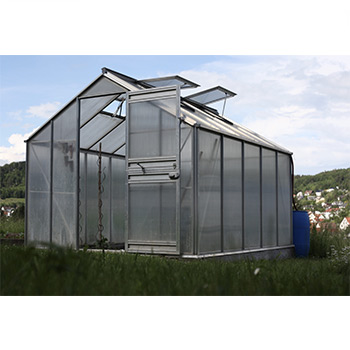
Let me come right out and say that you should stay away from untempered glass. Gardening accidents can happen easily, and tempered glass won’t break as easily as untempered glass.
And when it does break, it just shatters into tiny pieces that don’t leave large sharp edges.
If you don’t have that kind of budget, choose the type of greenhouse with polyethylene or perspex glass.
3. Design Type
You’ll most often find peaked and rounded dome greenhouses. But if you have a small yard, you may want to look at some of the lean-to choices that would attach to the structure of your house.
They are small and convenient, but a surprisingly effective way to increase your winter vegetables production.
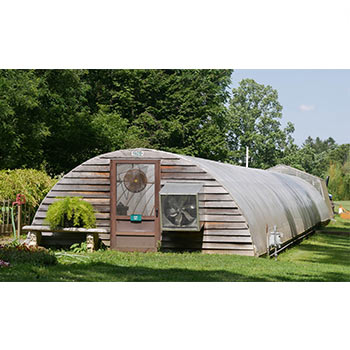
How To Choose The Right Type Of Winter Greenhouse
Before you pick a winter greenhouse, take the time to consider these three points.
1. Site
When choosing an ideal site on your property, consider where there will be the most amount of direct sunlight for your plants in winter.
It should ideally face south with no big trees that would result in shade.
2. Space
You can get greenhouses that lean against the structure of your home and only take a few feet of space in your garden.
The free-standing ones usually come as small as 6x6 feet. Obviously, the larger your greenhouse, the more plants you can grow inside and harvest throughout the year.
3. Climate
This is where you need to assess how cold and windy your winter months are. If you get a lot of snow for a few months, you may need to use a heating system.
And if it’s very windy, then you’ll need some more solid materials and possibly a foundation as well.
What Can Be Grown In A Winter Greenhouse?
My personal experience with my winter greenhouse crops has taught me to focus on cold-tolerant root vegetables and leafy greens.
Here are some examples of what I’m growing inside my greenhouse from October to March [1].
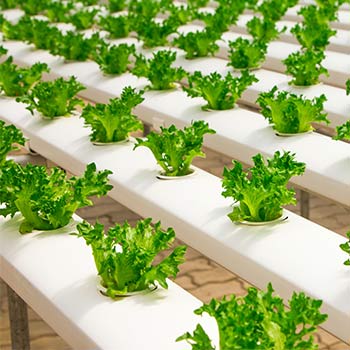
Some people would also plan to transplant then into their gardens once spring comes to speed up the first summer crop.
Now, you might also be able to grow some tomatoes and peppers in winter as long as temperatures don’t drop too much.
My personal experience has been a bit hit and miss with these as there is not enough full sun exposure in winter to boost growth.
When Is The Right Time To Plant Winter Crops?
I replant, transplant, and seed pretty much all-year-round depending on light conditions, and it’s important to note that there isn’t one best time.
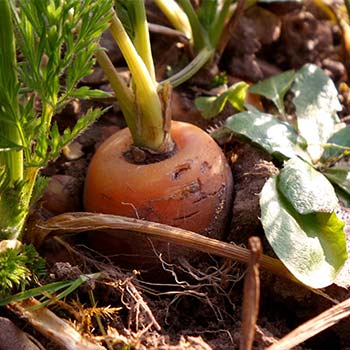
It all depends on what you grow and what the growth time is under ideal weather conditions.
For example, the carrots I plant take about two months to grow during the spring and summer. But even inside my greenhouse, it can sometimes take 70 or 80 days in autumn and winter.
This is because plant growth slows down when there is less daylight, even with hardy root vegetables.
The best thing to do is search for the maturity times of seeds and then plant them to spread your harvest.
Then add on about 10% extra time, otherwise, you’ll learn the hard way that your vegetable crop isn’t ready in time.
How Can I Heat My Greenhouse In The Winter?
If your climate results in many months of freezing temperatures and a heavy snow cover, then heating options might end up being a waste of time and money.
But if your winter season allows it, then a slight temperature boost in your greenhouse could give you a great harvest.
Here are some options I’ve seen successfully used to grow crops in my garden.
1. Automated Heaters
This is a more expensive option, but with an electric space heater linked up to a thermostat and timer, you could provide just enough daytime heat in winter, or in any season really, to get some more growth in your greens.
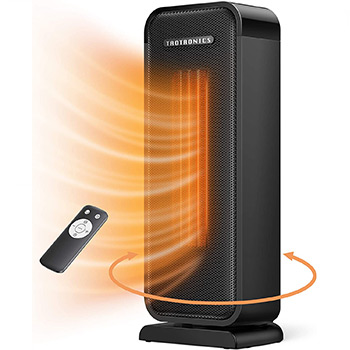
2. Insulation With Bubble Wrap
This was one of the best tips I got from a horticulturist. Buy a few rolls of bubble wrap and attach it to the inside of the glass.
It’ll help provide a higher temperature even in colder weather.
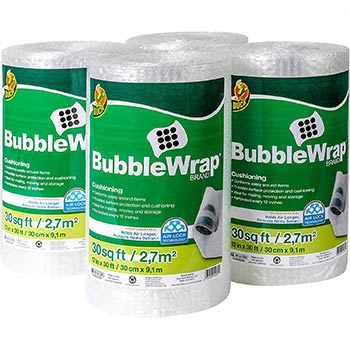
3. Water Barrels
If you’re planning on winter vegetable growing when building your greenhouse, add a passive solar collector such as a wall of black-painted water jugs. This will collect solar heat during the day and reflect it into the greenhouse at night, helping to prevent freezing.
Anne Bailey, Writer at gardeningknowhow.com.
4. Fleece Tunnels
These require a bit more work, and my personal experience hasn't been great.
But I know a few people who use them in much colder places, like Canada, to keep any heat closer to the plants.
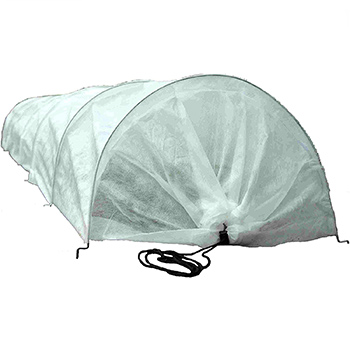
Tips To Successfully Grow Your Crops In A Winter Greenhouse
Growing plants year-round can seem like quite a challenge, and in my first year, I made a few mistakes that you should best avoid.
Here are four tips I like to keep track of in the winter season.
1. Avoid Overwatering
I often go for more than 10 days without watering. Because it doesn’t get that hot and the humidity levels are pretty high, this should be more than enough.
A trick I use is to have a few popsicle sticks that I stick in the soil. Leave it for a few minutes, and if it comes out slightly damp, then you should be OK.
2. Keep Fertilizing
You won’t need as much fertilizer as during the summer as the day's reduced light will slow down growing time.
But you should still allow for about half the amount you’d usually use for specific plants in summer. [2]
3. Boost Air Circulation
My biggest gardening mistake in my first winter season was not allowing enough fresh air circulation.
If you have vents, then make sure you open them regularly, especially when you get a very sunny day above freezing.
4. Remove Snow
This should be obvious, but snow on greenhouses will reflect away the sunlight like a mirror and reduce the heat inside. It’s always best to remove it as soon as you see a build-up.
FAQ
Yes, greenhouses work in the winter, but you need to plan for certain types of crops. Root and leafy vegetables are best suited for growth in winter, and you may need to introduce some heat sources if temperatures fall significantly.
Yes, a greenhouse will keep plants from freezing, as long as it gets enough sunlight. However, if you live in a particularly cold climate, you might need to use a heat source during the night.
Daytime temperatures below 20°F (around -7°C) would generally be too cold for an unheated greenhouse. Anything significantly below that might also become quite expensive to heat.
Your greenhouse might be colder than outside due to too much ventilation or conduction of heat. Check if you have a metal frame that is in direct contact with the ground or if you have a significant draft in your greenhouse.
An unheated greenhouse can remain frost-free if the outside temperature doesn’t go below 20°F (around -7°C). In good conditions, a greenhouse will stay about 9 degrees warmer than the outside.
You winterize a greenhouse by improving insulation and making sure it isn’t shaded during the day. You also want to check for unwanted drafts on windy days.
Yes, some seeds will germinate in a cold greenhouse, as long as the soil doesn’t get too cold. Depending on the seeds, germination and the first green shoots might take anywhere from 6 to 12 weeks.
Read More:
Conclusion
As long as you don’t have to battle arctic winter temperatures, a greenhouse can be one of the best ways to keep some tasty green crops growing well into the winter in the comfort of your home.
Just make sure you choose your crops wisely and stick with leafy greens and root veggies. And then a little bit of common gardening sense it should be enough to provide some fresh food until springtime.
References
- https://www.thompson-morgan.com/top-10-winter-vegetables
- https://ag.umass.edu/greenhouse-floriculture/fact-sheets/basic-fertilizer-programs-for-containerized-greenhouse-crops


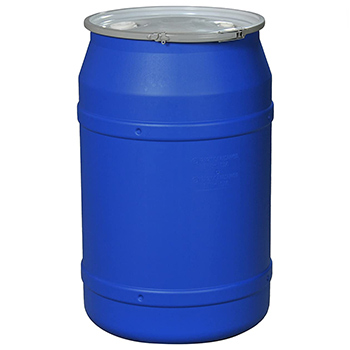



I have a new 7x 14 Gh I got a late start on plants this fall. Seeds wouldn’t germinate) so now just young plants with slow growth. Is there some way to boost growing? I have great south exposure, and better Ghouse, than the last 3 years with a block heat wall on north side 4’ high.